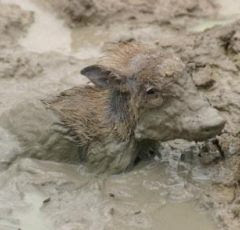 Like so many of our rituals Groundhog Day is a hand-me-down from pre-history. This one was restarted in the West by German immigrants to Pennsylvania about 200 years ago. Originally it was called Imbolc by its Pagan Celtic celebrators. Feburary 2nd, halfway between the winter solstice and the spring equinox, [on the new calander] was Imbolc. This very cool ancient celebration centered on the lactating of ewes as a fortelling of good fortune for their new lambs. All accross the Pagan world we find ruins built to celebrate this auspicious day.
Like so many of our rituals Groundhog Day is a hand-me-down from pre-history. This one was restarted in the West by German immigrants to Pennsylvania about 200 years ago. Originally it was called Imbolc by its Pagan Celtic celebrators. Feburary 2nd, halfway between the winter solstice and the spring equinox, [on the new calander] was Imbolc. This very cool ancient celebration centered on the lactating of ewes as a fortelling of good fortune for their new lambs. All accross the Pagan world we find ruins built to celebrate this auspicious day.Here in the southwest corner of Beautiful British Columbia none of fauna or flora saw their shadow at sunrise today prognosticating a forshortened winter and early spring. Mark Madrega, my favorite weatherman, agrees. So do the early appearing robins scrounging around in the compost pile, the blooming bulbs, the exploding chives and that most perfect predicter of spring, the first running of the lawnmowe being heard hither and yon.
Imbolc is traditionally a time of weather prognostication, and the old tradition of watching to see if serpents or badgers came from their winter dens is perhaps a precursor to the N. American Groundhog Day. A Scottish Gaelic proverb about the day is:
"The serpent will come from the hole
On the brown Day of Bride,
Though there should be three feet of snow
On the flat surface of the ground."


